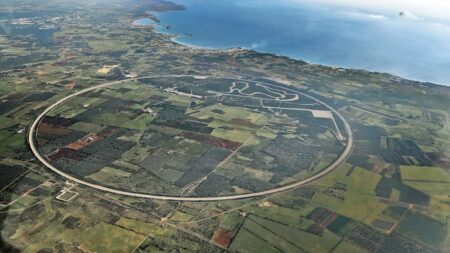Drivers looking for the ultimate Ferrari will be excited to see the FXX-K Evo, the latest evolution of the XX program. Ferrari develops extremely limited-run models specifically to play an active role in the XX research and development program, and even their use is extremely limited as they are homologated for road use and are not permitted to be used in competition outside their dedicated race program.
This car is aimed at the most enthusiastic – and indeed the wealthiest – of Ferrari’s clients, who are eager to take part in the development of technological innovations through driving a closed-wheel laboratory car. Some driving talent will be required for the Evo though, as it enhances the already brutal FXX-K with new developments and innovative concepts derived from the track categories in which Ferrari competes: Formula 1, GT3, GTE and the single-make Challenge championship.
For example, by drawing on its Formula 1 experience and adopting innovative carbon-fiber component crafting processes, Ferrari’s engineers have succeeded in producing a lighter car than the previous FXX-K, despite introducing new elements such as a fixed rear wing.
That wing is just one of many aerodynamic efficiency changes made to the car, which have also necessitated calibration work to the suspension, which has double wishbones at the front and multilink at the rear.
Downforce goes up
Ferrari’s engineers have worked closely with the Ferrari Style Centre’s designers to enhance the aero package for the Evo, spending over a year conducting CFD simulations and wind tunnel testing to develop aerodynamics that deliver downforce figures very close to the company’s GT3 and GTE championship cars. The result is more lateral acceleration in cornering, higher stability and – let’s not forget – driving pleasure.
Lest this sounds like just a few minor tweaks to sell more cars, or upgrades to existing cars, Ferrari says that the Evo delivers a 23% improvement in downforce coefficient over the FXX-K, which is the equivalent of a 75% increase over the road car from which it is derived. Downforce of 640kg is generated at 200km/h (124mph), and exceeds 830kg at the car’s red-line speed.
The downforce is boosted by a twin-profile fixed wing on the tail, which works with the active rear spoiler, with the pressure fields developed by the two downforce-generating systems supporting and amplifying each other. The wing is supported by two side fins and a central fin, the latter acting as a vertical fin to boost stability at low yaw angles, and supporting the action of the three delta (triangular) vortex generators.
The flow field striking the wing is ‘cleaned’ of the effects of the wake of the hot air flow from the radiators by the vortex generators, which vent the air onto the bonnet. The generators also create a downwash component in the flow, which boosts the twin-profile’s downforce capacity. The result is a 10% increase in the downforce developed by the rear system.
Flicks, flow and wake
The new flow structures necessitated modifications of the design of the rear bumpers, with the by-pass vent from the rear wheel arch enlarged, and the volume behind the wheels hollowing out to ensure the wake from the wheels is efficiently channelled. The result is that the flow to the rear diffuser is protected and losses are reduced, boosting downforce by 5%.
This increase in rear downforce had to be balanced by alterations to the design of the front bumpers and underbody. Thus the geometry of the sides of the front bumper was altered by hollowing out the surfaces beneath the headlights. This made space for a couple of ‘flicks’, divided by a vertical turning vane and an additional intake ahead of the front wheels. According to Ferrari, this system generates a 10% increase in downforce over the ‘standard’ FXX-K. The system also applies know-how acquired in the GT programs, in which rules introduced in 2016 permit extensive study of the interaction between horizontal (flicks) and vertical (dive plane) flow management systems, optimizing their efficiency.
Ground effect was also boosted by the introduction of vortex generators on the undertray. This capitalized on the accelerations created by the rear system and the front underbody, generating 30% of the extra downforce the car delivers compared to the FXX-K.
Of course this extra performance has to be tempered, new front brake air intakes specified which, although no wider (to avoid increasing drag), are more efficient thanks to a complete redesign of the intake itself.
The FXX-K Evo is currently undergoing around 5,000km of development runs and 15,000km of reliability test-drives.





